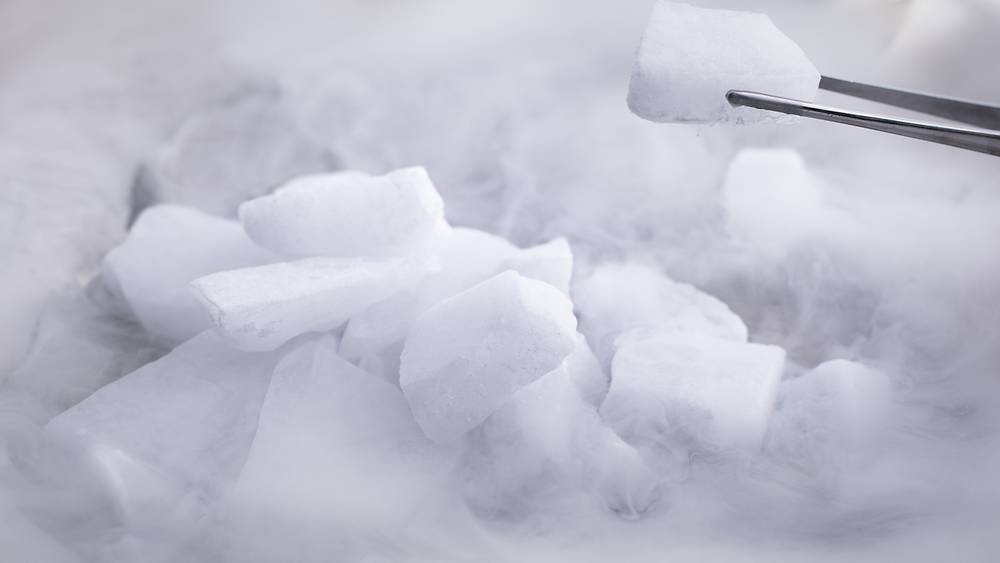Cargo news


Dry ice logistics – in a nutshell
There has been a lot of buzz around dry ice since the discussions started about transporting vaccines last autumn. However, dry ice as a component to keep frozen goods in the desired temperature has been around for decades. In 2020, Finnair Cargo carried over 300 tons of dry ice. In air transportation, it is classified as miscellaneous dangerous goods, class 9, which poses restrictions and additional safety regulations. If it has been a while ago since you took chemistry lessons, here’s one for logistics professionals.
Dry ice is solid carbon dioxide, which enables goods to stay frozen a lot longer than in normal ice. Dry ice does not melt into water but turns into gas when the temperature rises. This reaction is called sublimation. Sublimation is the reason why it is considered dangerous goods as by sublimating, the gas released increases the carbon dioxide level, therefore, oxygen levels are lowered, making it difficult to breathe. There is a strict limit posed by health and safety regulation on how much carbon dioxide there can be in the air where people work – 5000 particles per million (ppm), equalling 0.5% in total. Too much carbon dioxide in the air causes drowsiness, inability to focus and disorientation which can cause severe accidents if not handled correctly. The industry is currently widely using sublimation rates which are based on studies made by the Federal Aviation Administration (FAA). Based on average sublimations of several packages they gave two values: 2% sublimation rate for packages with less than 45kg of dry ice and 1% rate for packages containing more than 45kg of dry ice. Sublimation rate indicates how much of the dry ice is turned into gas in an hour. So, the more dry ice is packed in, the more it releases carbon dioxide gas in the air.
Generally, dry ice is used in pharmaceutical packaging, medical samples, specific alimentary samples and in some cases food products, such as premium ice cream. As dry ice can be a more expensive solution than normal ice, the content is usually more valuable than standard food products. Packaging cannot be fully airtight as sublimation gas must be released in the air. In the worst cases, sublimation can cause the explosion of packages if sealed too tightly. There are many forms of dry ice, pellets being one of the most used ones, and different types of dry ice will have their own sublimation rates. The actual rate depends on various factors: the volume and format of dry ice, air pressure, ventilation, needed temperature, transportation duration – just to mention a few of the key influencers.
In the context of air cargo transportation, packages containing dry ice are placed in cargo compartments where the sublimation will happen during the flight. The same space is also being used for example transporting live animals, and it also must be safe for staff to operate in. With the pressure of being able to carry higher volumes of goods packed with dry ice, operators have indicated their own limits, taking into account aircraft type technical specifications such as air exchange and hold volumes. As each package can have a different sublimation rate based on the aforementioned factors, this information is needed to calculate the most optimal volume of dry ice per aircraft. As the industry must use the sublimation rate of 1% or 2% if the precise rate is not available, a potential volume may be left unused.
The market indicates that more capacity to transport goods packed in dry ice is needed, therefore aircraft manufacturers have recently revised their own instruction. At Finnair, we have been preparing new processes to be able to calculate the exact sublimation rate per aircraft in order to maximise the dry ice capacity on one flight. The requirement for the calculations is the exact sublimation rate per package informed by the shipper. The main benefit for the shipper to provide this information to airlines is to optimise the volume of dry ice loads on one flight, speeding up the delivery and making it more efficient. The impact of the readiness is yet to be evaluated by the market. However, being prepared is always better than being caught off guard.
This article has been written with Henry Rantala, Manager of Compliance and Standards at Finnair Cargo. He has been working with Finnair for over 40 years and will be retiring end of January 2021.
Read more